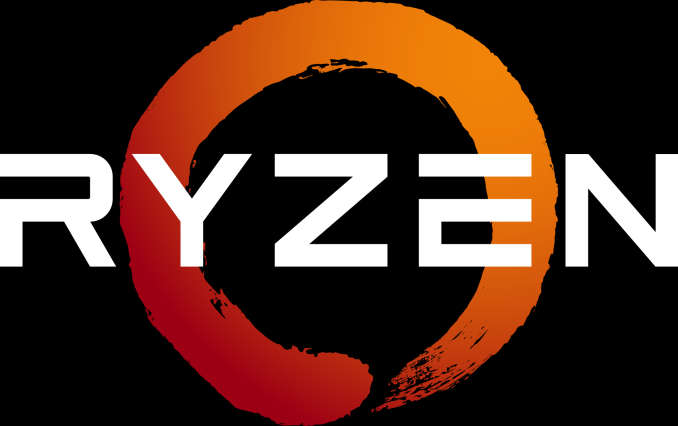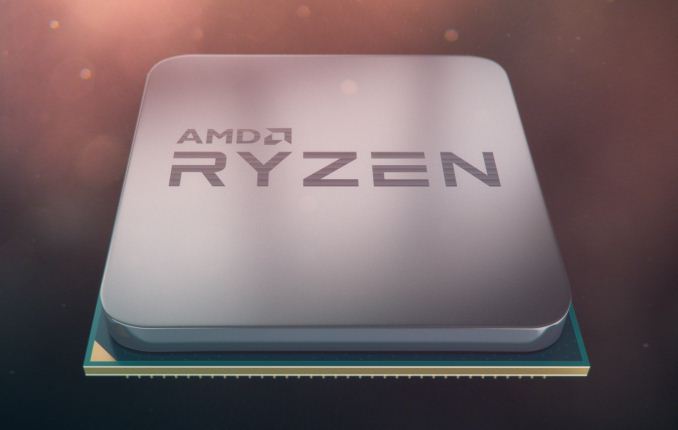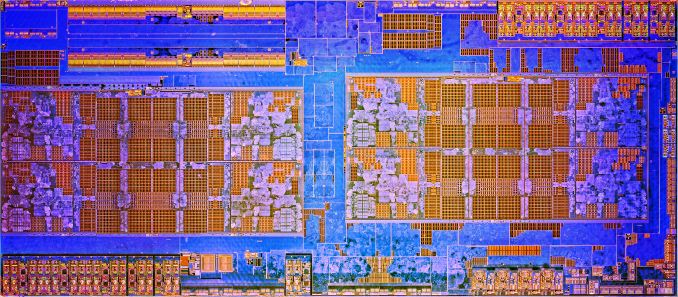AMD Launches Ryzen: 52% More IPC, Eight Cores for Under $330, Pre-order Today, On Sale March 2nd
by Ian Cutress on February 22, 2017 9:00 AM EST
The biggest x86 launch for AMD in five years is today: Ryzen is here. As always before a major launch, AMD gives a ‘Tech Day’ for relevant press and analysts, and through this event AMD’s CEO, Dr. Lisa Su lifted the lid on one of the most anticipated products in the semiconductor industry. AMD knows how to control the level of enthusiasm for its fans, and today is the end result, with processors going on pre-order from major retailers today at 1pm EST, ready for a general hard launch on March 2nd.
In a similar vein to launches of recent smartphones, AMD is doing a staggered announcement/launch with the products on their new microarchitecture. Where Samsung/Apple might give all the details for a product a few weeks before it’s available to buy, today on February 22nd marks the day where AMD is giving consumers information about Ryzen, and specifically the Ryzen 7 family of eight-core products. All the information today is from AMD, and AMD’s internal testing, and pre-orders also start from today for users ready to put down their money for a launch day part. Reviews of the CPUs, as well as when the CPUs will ship to customers, is on March 2nd. This also happens to be right in the middle of two annual shows, Game Developer Conference (GDC) and Mobile World Congress (MWC), making the time between receiving pre-launch samples and being able to provide independent verification of AMD’s performance claims relatively frantic. We’ll do our best!
The Ryzen Family
With a new processor launch, naming the parts and positioning them within the market is critical. So with Ryzen, the processor stack will be split into three based on performance and price: Ryzen 7 at the high end, Ryzen 5 in the middle, and Ryzen 3 for more price-conscious consumers. Both Ryzen 5 and Ryzen 3 are set to be launched later, and Ryzen 7 is the first portion of the family to be released.
Ryzen 7 will have three CPUs to start, all having eight cores and supporting simultaneous multi-threading:
- Ryzen 7 1800X: 8C/16T, 3.6 GHz base, 4.0 GHz turbo, 95W, $499
- Ryzen 7 1700X: 8C/16T, 3.4 GHz base, 3.8 GHz turbo, 95W, $399
- Ryzen 7 1700: 8C/16T, 3.0 GHz base, 3.7 GHz turbo, $329
Ryzen 7 1800X will be the high-end part, featuring a base clock of 3.6 GHz and a turbo of 4.0 GHz, within a TDP of 95W, and for $499. Next to this is Ryzen 7 1700X, launching at $399, with a base/turbo of 3.4/3.8 GHz. The final part for the launch is the Ryzen 7 1700, providing eight cores and sixteen threads for $329 at 3.0/3.7 GHz frequencies.
Processors will initially be available for pre-order from 185 retailers and OEMs worldwide, either as individual parts or pre-built systems.
What, not 40% IPC? 52% IPC??
Enthusiasts and analysts use the term IPC, or ‘Instructions Per Clock’, as a measure of how much the underlying microarchitecture improves from generation to generation. Two decades ago, a good design on a smaller node could net a healthy double-digit gain, whereas in recent years 5-10% gain has become the norm. When AMD initially announced that the new Zen microarchitecture they were developing was aiming for a 40% IPC gain, despite the low IPC they were starting from, users remained skeptical. AMD rehired Jim Keller to work alongside long-term AMD architect Mike Clark and produce a team with several goals in mind: high-performance x86, simultaneous multithreading, and a product to be relevant in the computing, PC, server and mobile space again. So despite this, 40% IPC always seemed a somewhat lofty goal, because Bulldozer was so underwhelming, and despite this low starting point. For the Ryzen launch today, AMD is stating that the final result of that goal is a 52% gain in IPC.
This is something we will need to test in due course!
The Ryzen Silicon, and the Future
AMD pointed out that the new 8-core silicon design runs 4.8 billion transistors and features 200m of wiring. Through previous announcements we’ve examined parts of the microarchitecture including cache sizes, threading, front-end/back-end design, and so on.
AMD Zen Microarchiture Part 2: Extracting Instruction-Level Parallelism
AMD Gives More Zen Details: Ryzen, 3.4 GHz+, NVMe, Neural Net Prediction, & 25 MHz Boost Steps
AMD’s CEO was keen to point out that this is a from-scratch design for AMD, using the knowledge gained from features developed for previous products but ultimately under the hood it looks like ‘a typical x86 high-performance core’, with AMD-specific features and tweaks. We were told that AMD’s roadmap extends into the multi-year range, so while the focus for 2017 will be on this family of products, back at HQ the next two generations are in various stages of development.
BENCHMARKS PLEASE
So despite the 82+ motherboards going to be available, 19 initial PC system builders moving into 200+ through the first half of 2017, the big question on everyone’s lips is how exactly does it perform?
Well, AMD gave us the following numbers:
AMD's benchmarks showed that the top Ryzen 7 1800X, compared to the 8-core Intel Core i7-6900K, both at out-of-the-box frequencies, gives an identical score on the single threaded test and a +9% in the multi-threaded test. AMD put this down to the way their multi-threading works over the Intel design. Also, the fact that the 1800X is half of the price of the i7-6900K.
In a similar vein, again with the Cinebench 15 multi-threaded test, the Ryzen 7 1700X scores over and above the Core i7-6800K (its price competition) and higher than the Core i7-6900K which costs 2.5 times as much.
We’ll tell you what our benchmarks say, with official retail processors. But you will have to wait until March 2nd. Sorry.





















386 Comments
View All Comments
warreo - Wednesday, February 22, 2017 - link
99% of people's jobs do not benefit much from Ryzen, and the vast majority of people buying it will in fact be gamers. Move out of your mommy's basement and get a real job, because your comment just announces your own stupidity.And spare me your fake "I'm a graphics artist/software developer/whatever other job that requires huge multitasking" comeback. Your company ain't paying for this, its buying an Intel machine. If you work for yourself and can afford a $500 CPU, guess what? You're part of the 1%.
BrokenCrayons - Wednesday, February 22, 2017 - link
Spending $500 on a microprocessor for a SOHO computer does not put you in the 1%. That's not, by any stretch of the imagination, a large enough sum of money to use as a measurement of someone's socio-economic ranking. When you get into the top 1% even homes (the average working person's largest asset) are relatively meaningless when net worth is taken into account and I'm not talking about your run-of-the-mill $300k starter home that most middle class types go eyeballs deep into debt for 30 years to occupy.fanofanand - Thursday, February 23, 2017 - link
As usual you are spot on. The 1% doesn't even know how much money they have, they have employees that worry about that sort of thing. The 1% have more money than they could ever spend, they drop $500 on a plate of sushi!warreo - Thursday, February 23, 2017 - link
My apologies, I was unclear, I wasn't actually referring to the "1%" rallying cry of Occupy Wall Street days. I meant the 1% of people who really need 8 cores for their jobs enough to justify dropping $500 on a CPU (on their own or their company's dime).My main point was to respond to Gothmoth's pointless comment -- Ryzen is in fact not for people with jobs. Ryzen is targeted at gamers, as AMD's own marketing will attest.
fanofanand - Thursday, February 23, 2017 - link
I get what you mean, I'm not a hater of the successful like some, I just think most people can't even imagine what being that wealthy is like.Back to the actual topic, AMD has marketed to gamers because their products weren't really competitive in anything else, and value was all they could offer. Most games aren't bottlenecked by the CPU so they made sense there. Hopefully now they can take a slightly more mature posture, and try to win over professionals and businesses. A thriving AMD is good for everyone including Intel. They needed a kick in the pants pretty bad.
BrokenCrayons - Friday, February 24, 2017 - link
Ah, I understand what you mean now! Sorry about my previous post, I tend to get a bit defensive when it comes to wealth. It seems like society in general tends to get pretty aggressive with people that aren't struggling so that makes it easy to assume anytime someone mentions the 1% that they're on the attack.Cooe - Sunday, February 28, 2021 - link
I REALLY hope you are one of those idiots that actually put their money where their retarded mouth was & bought a 4-core/4-thread i7-7600K in 2017 instead of a 6-core/12-thread Ryzen 5 1600 for their gaming rig. If so, how are those like 1/2 as high framerates & even WORSE frametimes vs the 6c/12t R5 1600 in modern games treating ya??? :Pprime2515103 - Wednesday, February 22, 2017 - link
You know what would be really funny? If these average a 5Ghz OC on air (the 4c/8t model). How long has Intel been all but promising that?This pricing structure is rather interesting. I remember AMD saying the prices on the Athlon 64 (if I'm remembering this right) would reflect their performance, and it did - the prices were uncharacteristically high for AMD, and with good reason.
I'm thinking that if all this PR hype ends up being BS, no one will ever trust AMD again and that will be the end of their desktop CPU days, if not the end of the company entirely. But what do I know...
Gothmoth - Wednesday, February 22, 2017 - link
..not much.negusp - Wednesday, February 22, 2017 - link
hypocrite much?